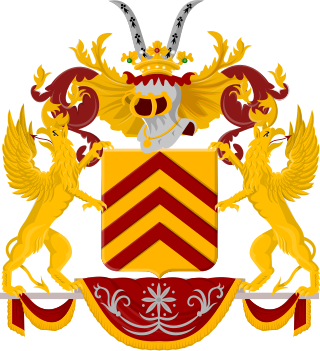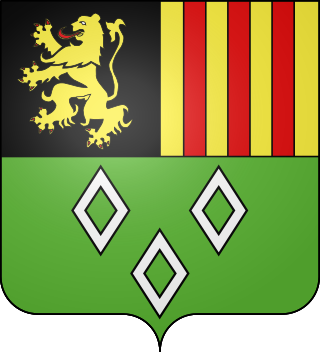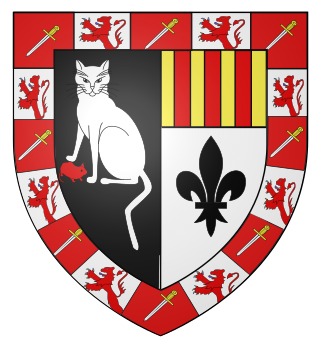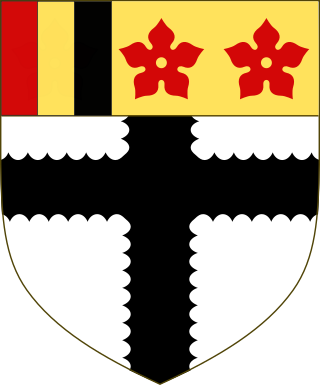
The House of Egmond or Egmont is named after the Dutch town of Egmond, province of North Holland, and played an important role in the Netherlands during the Middle Ages and the Early modern period. The main lines Egmond-Geldern, Egmond-Gavere and Egmond-Buren-Leerdam had high noble, princely rank.

The House of Hornes was an old and important European noble family, which became extinct in the male line in 1826. The name refers to Horn, a small village in Limburg, located in the Netherlands.

The Castle de Renesse is a castle located in the village of Oostmalle (Malle), in the Campine region of the province of Antwerp. It is currently owned by the municipality of Malle.

The Terlinden family is a Belgian noble family of German origin, with a noble offspring in Belgium. Its titles are Viscount and Baron.

The van Voorst tot Voorst family is an old Dutch noble family from the province of Overijssel.
René III of Renesse, Viscount of Montenaecken, Baron of Gaesbeeck, Lord of Elderen was a Dutch nobleman, who became the 1st Count of Warfusée in 1609. He acquired Gaasbeek Castle in 1615.

The Carpentier family is a noble family of French origins. One of its branches moved to the kingdoms of England and Scotland in the 15th century. Another branch, the Carpentier de Changy family, has been part of the Belgian nobility since 1892.

Van Zuylen van Nievelt is an old noble Dutch family originating from Utrecht.

The de Lalaingfamily is a noble family from the south of Flanders which played an important role in the history of the County of Hainaut and of the Netherlands. The current family belongs to the Belgian nobility.

The House of Lannoy is the name of an old and important Belgian noble family that takes its name from the town of Lannoy in northern France. The name comes from l'Annoy, which means 'the alderwood' in Picard French of Flanders.

The Van der Noot family is a Belgian noble family. The title of Count van der Noot is a title created by Emperor Charles VI on 16 May 1716. Since then this title belongs to the Belgian nobility.

The House of Glymes was an old Belgian noble family, an illegitimate branch of the House of Reginarid, which ruled the Duchy of Brabant. Glymes or Glimes is a municipality of Incourt. Their descendants of the branch of Grimberghen are styled as the Prince de Grimberghen.

Brimeu is a noble family, some members belonging to the Flemish aristocracy. Brimeux, previously in Flanders, is now in France.

Philippe François de Berghes (1646–1704) was a diplomat and military commander in the Spanish Netherlands and became the first bearer of the title of prince of Grimberghen.

The Snoy family or Snoy d'Oppuers currently Snoy et d'Oppuers, is a Belgian noble family. The current descendants are titled Barons Snoy and of Oppuers.

The House of Nassau-Corroy is a bastard branch of the House of Nassau. Unlike the main branch of the House of Nassau, this illegitimate branch was faithful to the king of Spain and Roman Catholic.

Belgian heraldry is the form of coats of arms and other heraldic bearings and insignia used in the Kingdom of Belgium and the Belgian colonial empire but also in the historical territories that make up modern-day Belgium. Today, coats of arms in Belgium are regulated and granted by different bodies depending on the nature, status, and location of the armiger.

The de Muyser Lantwyck family is an old Belgian family dating back to the beginning of the 15th century, tracing its roots to Jean Moyser, alderman of Vaelbeek, who held lands in Héverlé in 1451, censier of the Groenendael Priory, lord holding the lands and manor of Cockelberg by lease dated 19 June 1438, husband of Aleyde Crabbé.
The House of Aspremont-Lynden is the name of an important Belgian noble family, which might have originated from the House of Lynden, part of the Dutch nobility. Due to their properties and intermarriages, the family also became part of the German nobility.

The Jolly family is a Belgian noble family originally from London whose proven male-line parentage dates back to 1799.


















